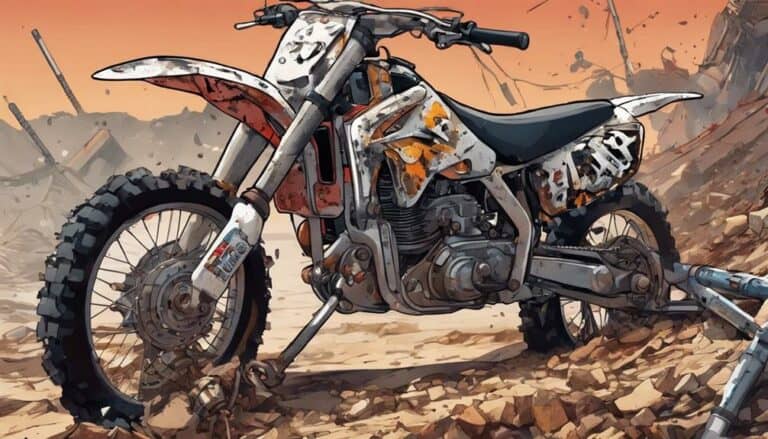When your dirt bike's motor suddenly falls silent, it's like the heartbeat of your ride coming to an unexpected halt. But why does this happen?
There are underlying causes that can bring your engine to a standstill, leaving you stranded in the dust. Delving into these reasons can not only shed light on potential issues but also help you prevent future breakdowns.
Let's uncover the mysteries behind why a motor ceases on a dirt bike.
Key Takeaways
- Overheating, inadequate lubrication, and neglected maintenance can cause a dirt bike engine to seize.
- Symptoms of a seized motor include power loss, unusual noises, and engine overheating.
- Prevent engine seizure by regular oil checks, temperature monitoring, and proper maintenance.
- Repair a seized engine by assessing damage, replacing faulty parts, and ensuring adequate lubrication for future use.
Common Causes of Dirt Bike Engine Seizure
Frequently, dirt bike engine seizures occur due to common factors such as overheating from prolonged high RPMs or inadequate cooling. When the engine overheats, the metal components expand, leading to increased friction and potential damage. This can ultimately result in a seized engine, where the moving parts are immobilized due to the excessive heat and stress.
Another critical factor that can contribute to a seized engine on a dirt bike is the engine oil. Insufficient lubrication from using low-quality oil or neglecting regular oil changes can cause friction between the engine's components, leading to increased wear and the potential for seizure. Proper lubrication is essential for reducing heat and minimizing friction within the engine, ensuring smooth operation and preventing catastrophic failures like engine seizures.
To avoid engine seizures, it's essential to use high-quality engine oil, adhere to recommended maintenance schedules, and monitor oil levels regularly. Neglecting these vital aspects can increase the risk of a seized engine and potentially costly repairs.
Symptoms of a Seized Motor on a Dirt Bike
When a dirt bike motor seizes, noticeable symptoms manifest, indicating potential issues with the engine's functionality. Loss of engine power and difficulties in acceleration are common indicators of engine seizing, often caused by a lack of lubrication.
Unusual engine noises such as knocking or rattling can also point towards a potential motor seizure issue, signaling internal damage due to inadequate lubrication.
Overheating of the engine, resulting in increased temperatures, is another key sign of a seized motor on a dirt bike, often a consequence of insufficient lubrication to reduce friction and heat buildup.
The sudden locking or freezing of the engine can make starting or operating the dirt bike challenging, showcasing the severe effects of engine seizing.
Additionally, difficulty in operating the clutch lever smoothly can be a symptom of a seized motor, emphasizing the importance of proper lubrication and maintenance to prevent engine seizure issues.
Preventative Maintenance to Avoid Engine Seizure
To prevent engine seizure on a dirt bike, maintaining proper oil levels and adhering to recommended oil change intervals are critical steps in ensuring sufficient lubrication. Here are three essential preventative maintenance practices to help you avoid engine seizure:
- Regular Oil Level Checks: Routinely check your oil levels to confirm they're within the specified range. Low oil levels can lead to inadequate lubrication, increasing the risk of engine seizure.
- Adherence to Oil Change Intervals: Follow the manufacturer's recommended oil change intervals diligently. Fresh oil helps maintain proper engine lubrication, reducing the likelihood of components seizing due to friction.
- Temperature Monitoring: Keep an eye on the engine temperature while riding. Unusual spikes in temperature could indicate potential issues leading to engine seizure. Address any overheating promptly to prevent damage to the engine components.
Repairing a Seized Engine on a Dirt Bike
Repairing a seized engine on a dirt bike typically involves disassembling the engine to assess damage, replacing faulty components, and ensuring adequate lubrication for future operation.
When an engine seizes, it's often due to issues with components like the connecting rod or problems in the bottom end of the engine. To start the repair process, you'll need to carefully take apart the engine to locate the damaged parts. Inspect the connecting rod for any signs of bending or warping, as this can cause serious internal damage.
In the bottom end, check for issues like worn bearings or damaged crankshaft components. Once the faulty parts are identified, they should be promptly replaced with high-quality replacements to restore the engine's functionality.
Proper lubrication is important to prevent future seizures, so make sure the engine oil is changed regularly and that the right type of oil is used.
Tips for Extending the Life of Your Dirt Bike Engine
To effectively extend the life of your dirt bike engine, prioritize regular cleaning and replacement of air filters to prevent the entry of damaging dirt and debris. Ensuring the air intake remains clean is important for best engine performance and longevity. Additionally, using a high-quality oil filter can further prevent engine damage by trapping harmful particles and contaminants. Regularly inspecting and replacing the oil filter according to the manufacturer's recommendations is essential for maintaining a healthy engine.
- Clean and Replace Air Filters: Regular maintenance of air filters prevents dirt and debris from entering the engine, reducing the risk of damage.
- Use High-Quality Oil Filters: Investing in quality oil filters helps trap harmful particles and contaminants, preserving the engine's health.
- Follow Manufacturer Recommendations: Adhering to the manufacturer's guidelines for oil filter replacement ensures proper engine protection and longevity.
Adhering to these practices will help prevent engine issues and extend the life of your dirt bike's engine.
Conclusion
To sum up, dirt bike engine seizures can be avoided with proper maintenance and monitoring.
Did you know that 90% of dirt bike engine failures are due to overheating or lack of lubrication?
By following manufacturer guidelines, checking oil levels, and listening for unusual sounds, you can prevent costly repairs and keep your dirt bike running smoothly for years to come.
Stay proactive and attentive to make certain your motor stays in top condition.

